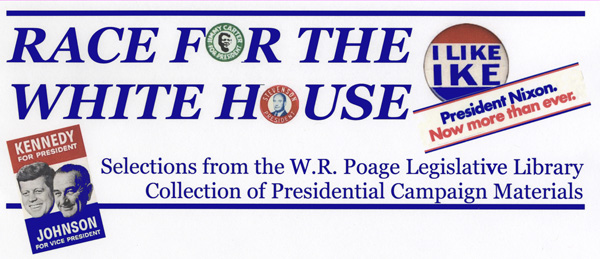Presidential Campaign Memorabilia Exhibit Open At The Baylor Collections Of Political Materials

Media contact: Lori Fogleman, director of media communications, (254) 710-6275
In an era when political campaigning is highly driven by television and the Internet, the tangible objects of past presidential elections - the buttons, bumper stickers, pennants and even the occasional necktie - remind Americans of a time when these items were nearly all candidates had to get their name and message to the people and get the vote.
In the midst of this much-anticipated presidential election, The Baylor Collections of Political Materials (BCPM) has opened a new exhibit - "RACE TO THE WHITE HOUSE" - that features an extensive collection of campaign materials from past presidential elections. The exhibit includes memorabilia from U.S. presidents, such as John F. Kennedy, Dwight D. Eisenhower, Franklin D. Roosevelt and Lyndon B. Johnson, as well as some presidential hopefuls, including Barry Goldwater, Wendell Willkie, Eugene McCarthy and Edward Kennedy.
On display in the W.R. Poage Exhibit Gallery through summer 2008, the "RACE TO THE WHITE HOUSE" exhibit features how each candidate used different types of materials as a way to appeal to different audiences and gain their support.
"All of the campaign items on display - buttons, hats, banners, stickers, t-shirts, pins, pennants, brochures - were used as tools of persuasion in a presidential campaign," said Erin Wolfe, a museum studies graduate student at Baylor and "RACE TO THE WHITE HOUSE" exhibit intern. "Presidential candidates are required to find support among individual voters, and these objects helped get their name, image, ideas and, most importantly, their message out to the public."
The "RACE TO THE WHITE HOUSE" exhibit also examines the clever use of slogans throughout presidential campaigns, as well as how some candidates used striking colors - aside from the traditional red, white and blue - to capture the attention of potential voters.
A MEMORABLE MESSAGE
"One of the most memorable campaign slogans is Dwight D. Eisenhower's 'I Like Ike,' which was printed on buttons, posters, stickers, hats - you name it," Wolfe said. "'LBJ All the Way' and 'LBJ for the USA' are two well-remembered slogans used in the presidential campaigns of Lyndon B. Johnson."
But Wolfe said sometimes candidates or opposing parties can use slogans to criticize other candidates.
"Barry Goldwater's 1964 slogan 'In Your Heart, You Know He's Right' was met with 'In Your Guts, You Know He's Nuts' from his opponents," she said.
Presidential candidates usually choose simple and short, but authoritative and commanding slogans. Some examples that can be seen in the Baylor exhibit are Richard Nixon's "Nixon's the One," Ross Perot's "Ross for Boss," "Gimme Jimmy" used by Jimmy Carter and "The Time is Now" used by Ronald Reagan in his 1980 campaign.
Other noteworthy items on display are personalized materials, an assortment of unique buttons, rare pennants and FDR banners, and select items like a Kennedy campaign hat, Reagan elephant visor and "Nixon for President" necktie.
OBJECTS OF AN ELECTION
The first mass market campaign was introduced in 1840. This was the first time voters actually knew what the candidates looked like. Common campaign items from the 19th century include snuff boxes, parade torches, medals, posters, ribbons, flag, and paintings under small pieces of glass.
One of the most popular and perhaps most collected pieces of political memorabilia is the campaign button. Patented in 1894, the celluloid button (what Americans still see today) was first used in the 1896 presidential campaign between William McKinley and William Jennings Bryan. After the black, white and sepia tones of the 1920's, buttons began to get more and more colorful. Today some even include electric lights and moving parts.
Recently, many campaigns have abandoned the celluloid button in favor of less expensive lapel stickers. Another recent trend has been the use of "web buttons," which Internet users can place on their personal websites. This offers an economical alternative which can be widely distributed, a key component of an effective campaign.
Items in the "RACE TO THE WHITE HOUSE" exhibit are from the collections of Robert Platt, Ben Guttery, Jack Hightower, Hyde Murray and W.R. Poage.
For more information, contact Ben Rogers, BCPM director, and Erin Wolfe at (254) 710-3540.
About the Baylor Collections of Political Materials
The Baylor Collections of Political Materials is a research facility that collects congressional records and personal papers related to the political history of Central Texas, with a mission of supporting programs designed to inform and educate students, scholars and the general public on the history of Congress, the legislative process, and current issues facing both local, state and national governments. The BCPM was established in 1979 in honor of Congressman W.R. Poage, Baylor alumnus and retired public official whose career spanned more than 50 years.
The BCPM currently houses the papers of 12 former members of Congress, six Texas legislators, five judges, one Lieutenant Governor, an editorial cartoon collection, extremist organizations' materials and records of the McLennan County Democratic Party. In addition, the BCPM contains a map collection, an extensive campaign materials collection, and an 8,000-volume book collection focusing on Congress, political history and areas of public policy.
Directions to Poage Legislative Library and the BCPM: Exit I-35 onto University Parks Drive, turn right into the drive between the Wiethorn Visitors Center and Hooper-Schaefer Fine Arts Center. (You will see the Jesse H. Jones Library straight ahead.) Park in the visitor's lot to the right. As you face Jones Library, the Poage Legislative Library can be found around the right of Jones and across from the Castellaw Communications Center.